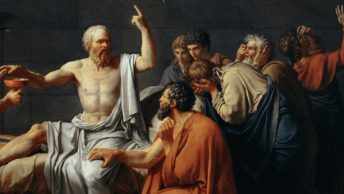 It was recently revealed that the “Common Core” curriculum crams partisan political ideas into children’s minds. For example, a grade school grammar exercise has students write, “[The president] makes sure the country’s laws are fair,” “Government officials’ commands must be obeyed,” and ”An individual’s wants are less important than the nation’s well-being.”
It was recently revealed that the “Common Core” curriculum crams partisan political ideas into children’s minds. For example, a grade school grammar exercise has students write, “[The president] makes sure the country’s laws are fair,” “Government officials’ commands must be obeyed,” and ”An individual’s wants are less important than the nation’s well-being.”
Though troubling, this offense is merely a symptom of a much greater problem—the persistent fallacy that students cannot be taught how to think and must therefore be told what to think.
That fallacy was born a century ago, when the National Education Association reversed its position on the aim of education. In 1893 it had proposed for all students a rigorous curriculum emphasizing “training the powers of observation, memory, expression, and reasoning.” However, in 1911 it replaced that goal with training for “citizenship,” and seven years later went further, declaring most students incapable of mastering academic subjects and consigning them to vocational courses.
Many influential people joined the chorus. For example, Lewis Terman warned of the “great army of incapables, shading down to those who should be in schools for dullards or subnormal children.” He also urged educators to “abandon, once and for all, the effort to bring all children up to grade.”
The education establishment obeyed. They began stuffing minds with information rather than developing mental skills. Textbooks became repositories of data rather than challenges to perception and judgment. Academic excellence was redefined as possessing large quantities of facts rather than evaluating information and reaching sound conclusions. “Objective” tests replaced essay tests. Most important, teachers’ colleges elevated these changes to the status of educational doctrine.
The new perspective on education was summed up by a high school principal in 1951 when he told a national conference, “Not every child has to read, figure, write and spell . . . many of them either cannot or will not master these [challenges].”
Ironically, long before the principal expressed that pessimistic assessment, scholars had shown it to be mistaken. In 1904, Charles Spearman demonstrated that critical, analytical thinking can be taught and learned. Other distinguished scholars, including Graham Wallas, Ernest Dimnet, and John Dewey (yes, that John Dewey) argued that teaching students how to think well should be central to education at every level. Dewey was particularly insistent that teachers should ask questions that provoke the exploration of ideas rather than ones that elicit rote responses.
The evidence for thinking instruction was so abundant that Edward Glaser could offer over 300 citations in his 1941 classic, An Experiment in the Teaching of Critical Thinking. The fields covered by the research included science, mathematics, English, logic, and social studies. Glaser demonstrated that any course can teach thinking skills, but only if that is a specific goal of instruction. And the evidence continued to mount after Glaser’s book.
Bernadine Schmidt succeeded in raising the IQs of 252 children from “feeble-minded” to “normal” through intensive cognitive instruction.
Israeli psychologist Reuven Feuerstein found that a central feature of mental deficiency is an “episodic grasp of reality”—the habit of seeing every object or event “in isolation without any attempt to relate or link it to previous or anticipated experiences in space and time.” And he proved that the habit can be broken.
Australian scholar Alma Brewer conducted a ten-year study in which she gradually changed students’ activities from simply recalling information to applying their learning to problem solving. Despite the increasing demands on students, their learning improved dramatically.
American scholars Howard Barrows and Robyn Tamblyn demonstrated that the lecture method produced medical school graduates who forgot most of what they had learned, including basic anatomy and physiology. Barrows then developed a problem-based approach that improved learning significantly. (He later showed how this system can be applied to K-12 education.)
The efforts of many scholars associated with the Critical Thinking Movement brought renewed attention to the value of problem solving and decision making in the classroom and developed relevant teaching materials.
Unfortunately, all this evidence was overshadowed by two well-intentioned but foolish educational initiatives that managed to garner public support. One was E. D. Hirsch’s Cultural Literacy movement, which argued that since students were shockingly ignorant of basic knowledge, mind stuffing should be increased. That was much like finding a sieve is leaking and deciding to correct the problem by pouring larger amounts of water into it.
The other foolish initiative was the Self-Esteem movement sparked by Abraham Maslow’s famous pyramid of needs, specifically by his idea that self-esteem is prerequisite to achievement (an idea he himself eventually came to doubt). Many educators jumped on the self-esteem bandwagon and abandoned the teaching of thinking on the absurd theory that saying “Agatha, your reasoning is flawed” would damage her self-image and trigger emotional trauma.
Thus did the nutty notion that people cannot be taught how to think because they are too stupid (or fragile) triumph yet again over meaningful educational reform.
It is fine to object when educators cram partisan political ideas into students’ minds, as seems to be the case with the Common Core curriculum. But we ought to object louder and longer to the entire framework of education into which that curriculum has been installed.
Copyright © 2013 by Vincent Ryan Ruggiero. All rights reserved








